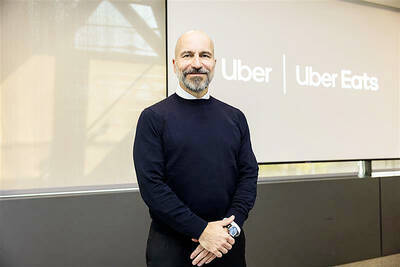Asia Pacific Telecom Co (亞太電信) is looking to have 20 percent of its subscribers on 5G by the end of the year to catch up to its peers, it said yesterday.
“Most local telecoms aim to shift 20 percent of their users to 5G this year,” company president Huang Nan-ren (黃南仁) told a media briefing after the company’s extraordinary shareholders’ meeting.
“We have set a very high target internally to match our rivals’ pace. Asia Pacific rolled out 5G services in October last year, lagging behind peers,” Huang said, adding that “it takes time to see an uptake.”

Photo: CNA
By the end of this year, the company plans to have about 400,000 of its 2 million users on 5G.
Since its 5G launch, Asia Pacific, the telecom arm of Foxconn Technology Group (富士康科技集團), has attracted new subscribers, mostly for 5G, Huang said.
This is different from what the big three telecoms have seen, as most of their 5G users were existing subscribers, he added.
As much as 60 percent of Asia Pacific’s 5G users signed up for packages with monthly fees of NT$999, which has helped lift the company’s average revenue per user, he said.
Asia Pacific offers 5G on bandwidth leased from Far EasTone Telecommunications Co (遠傳電信), serving as a mobile virtual network operator. To make sure it can build a stronghold in the market, Asia Pacific is moving to share and cobuild 5G networks with Far EasTone through a strategic partnership.
To boost 5G coverage, Asia Pacific is making a multi-operator core network that it hopes to launch in the third quarter, as soon as regulators approve the 5G sharing project, Asia Pacific chairman Lu Fang-ming (呂芳銘) said.
Company shareholders approved a new offering of 750 million common shares, with 500 million shares designated for Far EasTone through a private placement. Far EasTone would become Asia Pacific’s second-biggest shareholder after obtaining the shares, giving it an 11.58 percent stake.
Far EasTone has deployed 6,000 5G base stations, giving it a coverage rate of 70 percent of its network.
Asia Pacific’s losses widened to NT$5.83 billion (US$207.17 million) last year, compared with losses of NT$5.2 billion in 2019, which it attributed to stiff price competition and heavy equipment depreciation totaling NT$4.28 billion last year.
“Our company has not reached economic scale yet,” Lu said.
Revenue fell at annual rate of 4.63 percent to NT$13.59 billion last year, from NT$14.25 billion in the previous year.

CHIP RACE: Three years of overbroad export controls drove foreign competitors to pursue their own AI chips, and ‘cost US taxpayers billions of dollars,’ Nvidia said China has figured out the US strategy for allowing it to buy Nvidia Corp’s H200s and is rejecting the artificial intelligence (AI) chip in favor of domestically developed semiconductors, White House AI adviser David Sacks said, citing news reports. US President Donald Trump on Monday said that he would allow shipments of Nvidia’s H200 chips to China, part of an administration effort backed by Sacks to challenge Chinese tech champions such as Huawei Technologies Co (華為) by bringing US competition to their home market. On Friday, Sacks signaled that he was uncertain about whether that approach would work. “They’re rejecting our chips,” Sacks

NATIONAL SECURITY: Intel’s testing of ACM tools despite US government control ‘highlights egregious gaps in US technology protection policies,’ a former official said Chipmaker Intel Corp has tested chipmaking tools this year from a toolmaker with deep roots in China and two overseas units that were targeted by US sanctions, according to two sources with direct knowledge of the matter. Intel, which fended off calls for its CEO’s resignation from US President Donald Trump in August over his alleged ties to China, got the tools from ACM Research Inc, a Fremont, California-based producer of chipmaking equipment. Two of ACM’s units, based in Shanghai and South Korea, were among a number of firms barred last year from receiving US technology over claims they have

It is challenging to build infrastructure in much of Europe. Constrained budgets and polarized politics tend to undermine long-term projects, forcing officials to react to emergencies rather than plan for the future. Not in Austria. Today, the country is to officially open its Koralmbahn tunnel, the 5.9 billion euro (US$6.9 billion) centerpiece of a groundbreaking new railway that will eventually run from Poland’s Baltic coast to the Adriatic Sea, transforming travel within Austria and positioning the Alpine nation at the forefront of logistics in Europe. “It is Austria’s biggest socio-economic experiment in over a century,” said Eric Kirschner, an economist at Graz-based Joanneum

OPTION: Uber said it could provide higher pay for batch trips, if incentives for batching is not removed entirely, as the latter would force it to pass on the costs to consumers Uber Technologies Inc yesterday warned that proposed restrictions on batching orders and minimum wages could prompt a NT$20 delivery fee increase in Taiwan, as lower efficiency would drive up costs. Uber CEO Dara Khosrowshahi made the remarks yesterday during his visit to Taiwan. He is on a multileg trip to the region, which includes stops in South Korea and Japan. His visit coincided the release last month of the Ministry of Labor’s draft bill on the delivery sector, which aims to safeguard delivery workers’ rights and improve their welfare. The ministry set the minimum pay for local food delivery drivers at